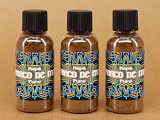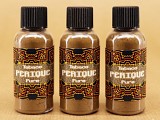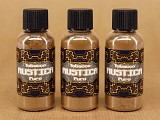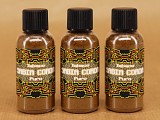Bottle, 10 Ml, 7 Gr from Brazil (SKU 4770)
Arapiraca Corda Tabaco, from Brazil’s renowned Tabaco region, is a premium choice for Rapé production due to its grounding effects and rich aroma. Traditionally crafted and fermented, this Tabaco undergoes a meticulous process to create a fine, smooth powder ideal for blending. When mixed with sacred ashes like Tsunu or Parika, Arapiraca enhances mental clarity and spiritual focus, offering a balanced and potent Rapé experience. Valued in indigenous ceremonies, Arapiraca Tabaco helps cleanse energies and align the spirit, making it a powerful tool for those seeking depth in meditation and spiritual practices. Detailed information can be found below.
Packed in 10 ml clear plastic bottles containing 7 gr.
| change currency | |||||||||
| SKU | Part | Volume | Weight | Unit | Price | Qty
|
|||
|---|---|---|---|---|---|---|---|---|---|
| 4770 | bottle | 10 ml | 7 gr | 1 pc | $ 7.56 | ||||
| 4771 | bottle | 25 ml | 15 gr | 1 pc | $ 15.11 | ||||
| 4772 | pot | 60 ml | 35 gr | 1 pc | $ 30.23 | ||||
| 4773 | pot | 100 ml | 55 gr | 1 pc | $ 44.08 | ||||
Arapiraca Corda Tabaco: Tradition, Craftsmanship, and Versatility
Overview
Arapiraca Corda Tabaco, originating from the renowned Arapiraca region in Alagoas, Brazil, is celebrated for its rich, earthy flavor and cultural heritage. Known as “The Brazilian Tabaco Capital,” Arapiraca has long been a hub for Tabaco cultivation and craftsmanship, particularly famed for its “Corda” or rope-style Tabaco. While traditionally crafted into thick, twisted ropes, Arapiraca Tabaco is now available in a finely powdered form, offering a unique opportunity for personal Rapé creation. This finely ground version retains all the Tabaco’s robust characteristics, making it ideal for spiritual practices focused on grounding and mental clarity.
Fermentation and Curing Process
The transformation of Arapiraca Corda Tabaco into fine powder is a meticulous process. Freshly harvested Tabaco leaves are fermented to develop their distinctive flavor, deep brown color, and long-lasting strength. During fermentation, natural chemical reactions convert starches and sugars, creating a smoother, stronger Tabaco that’s perfect for ceremonial use. The ropes are then carefully aged, allowing the Tabaco to mature into its characteristic robust form.
To create the powdered version, the Tabaco ropes are cut into small pieces, sun-dried, crushed, dehydrated, and deveined. The leaves are then repeatedly ground and sieved until they reach a fine 150-micron consistency. This labor-intensive process ensures that the powder maintains Arapiraca’s signature aroma and potency, making it well-suited for blending into Rapé with a smooth, balanced texture.
Applications in Rapé Blends
Powdered Arapiraca Corda Tabaco is prized for its grounding effects and versatility in creating personalized Rapé blends:
Rapé Blending: The fine powder of Arapiraca Corda Tabaco mixes seamlessly with sacred ashes like Tsunu or Parika, creating a potent and balanced Rapé blend ideal for meditation and spiritual clarity. Typically mixed in a 1:1 ratio with ashes, Arapiraca-based Rapé provides a steady, grounding effect that is especially valued in indigenous spiritual practices aimed at energy alignment and mental focus.
Spiritual Cleansing and Protection: In powdered form, Arapiraca Tabaco supports rituals for mental and energetic cleansing, making it a key component in spiritual ceremonies where clarity and focus are essential. Its grounding properties help users connect deeply with the earth and engage in introspective practices, offering clarity during spiritual journeys.
Nasal Inhalation and Liquid Applications
In addition to its use in Rapé, Arapiraca Tabaco juice—extracted by soaking the leaves—is used for nasal inhalation, believed to clear nasal passages, improve focus, and remove energetic blockages. At Katukina, we offer a refined liquid extract of Arapiraca in a convenient nasal spray, providing an accessible, controlled method for experiencing its effects.
Cultural and Spiritual Significance
Arapiraca Corda Tabaco powder embodies the rich tradition of Brazilian Tabaco craftsmanship and holds deep cultural and spiritual meaning. Indigenous healers and tabaqueros highly regard it for its grounding and protective qualities, viewing it as a conduit between the physical and spiritual realms. The Tabaco’s role in local practices also sustains cultural heritage, with generations of farmers in Arapiraca passing down their expertise in cultivation, fermentation, and powdering techniques.
A Sacred and Versatile Tool
Whether used in Rapé blends or in spiritual rituals, powdered Arapiraca Corda Tabaco offers a balanced, powerful experience. Its fine texture allows for easy blending and personalization, making it ideal for both seasoned practitioners and those exploring the art of Rapé. For those seeking a deeper connection to themselves and the earth, Arapiraca Corda Tabaco in its powdered form provides a versatile tool for grounding, clarity, and spiritual focus.
To read a more comprehensive article on Arapiraca Tabaco, click here.
Setting the Standard for Ultra-Fine Tabaco powder
We take great care to ensure the highest and finest quality Tabaco powder for your use. To guarantee purity and consistency, we meticulously sieve the Tabaco, removing any rough bits and impurities. The result is an ultra-fine powder, sifted to a 150-micron fineness using advanced dehydrating equipment and laboratory-grade sieves. This process ensures smooth, clean ashes, providing an enhanced experience for all your Rapé preparations.
Create your own Rapé with Tabaco powders and Ashes
Ever been curious how to make your own blend of Rapé? Rapé preparations are usually based on two distinct ingredients: Tabaco and ashes, which can be mixed with a wide variety of other aromatic or medicinal components to your liking. More information on the process can be found here.
Disclaimer
The information provided above is for historical, educational, and scientific purposes only. It should not be interpreted as a recommendation for the specific use of our products. Any statements about traditional uses are informational. The use and application of our products are the customer's decision and responsibility.
Copyright Notice
All content, including this article, is protected under copyright law. Any unauthorized reproduction, distribution, or use of this material is prohibited. Duplication of this content, in whole or in part, without written consent, is a violation of copyright regulations.
Other names: Corda
All South American shamans have an intimate relationship with Tabaco, and consider it a very sacred, wholesome plant that is deeply entrenched in their culture and rites. Tabaco consumed in high amounts has strong psychedelic and hallucinogenic effects, as it contains two alkaloids, harman and norharman, which are closely related to harmine and harmaline (Janiger et al. 1973). These two beta-carbolines inhibit monoamine oxidase (Herraiz et al. 2005), leading to antidepressive and uplifting effects (Farzin 2006).
In addition to Ayahuasca rituals that are combined with Tabaco snuffs, there are even shamans that specialised in Tabaco healing, called Tobaqueros (Jauregui et al. 2011). When used in shamanic rituals, Tabaco is assumed to protect, cleanse and re-align energies, thereby bringing profound clarity and healing (Jauregui et al. 2011). Furthermore, South American shamans, commonly use Tabaco smoke to blow it over the person to be healed with the intention to bring their energies into equilibrium and clean out all negativity and anxiety (i.e. ‘sopladas’ – the healing energy of blowing) (Jauregui et al. 2011). Thus, Tabaco in the shamanistic culture has a potent function of cleansing, bringing clarity and focus, and for allowing strong visualisations.
This powder is made from fermented Rope Tabaco. When the Tabaco is harvested it is first fermented and then turned into ropes and rolled up on rolls, each roll can weigh around eighty kilo. After this process it sits on the rolls to mature. When they prepare the Tabaco for Rapé it is dried in the sun, beaten and sieved.
This item is not allowed in the following countries:
Finland, United Kingdom
This natural product is offered for its ethnographic and historical value and is delivered with no expressed or implied fitness for a specific purpose. It is simply a raw botanical specimen, or a scientific sample. The information provided is purely meant for historical, scientific and educational purposes and should never be interpreted as a recommendation for a specific use. The use and application of our product is at the customer's decision, responsibility and risk.
Read our Terms & Conditions for more details.





